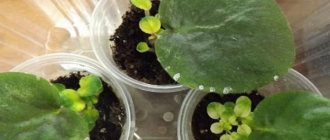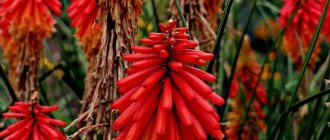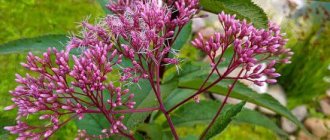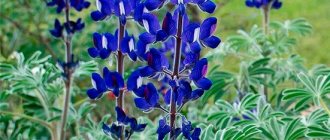The milky white corydalis flowers are much more beautiful than most other flowers because they have a larger and wider lip. The 10 or more flowers per stem also grow tightly together - possibly because the species has twice the normal number of chromosomes.
Author of the article
Eduard Dmitriev
Florist and lover of indoor and garden plants.
Thus, although the height of the corydalis is about 20 centimeters, one plant will have an impact on the overall appearance of the garden. In the wild, tuberous corydalis grows in the North Caucasus and in the upper reaches of two river valleys - Kuban and Malka.
Description
The name Corydalis comes from the Greek korydalis, which means crested lark, in reference to the shape of the flowers. There are about 450 species, 330 of which are native to China and Tibet. Some varieties are found in Sweden, southern Finland, the Urals, central Europe, Spain and Greece. But the red and pink forms are mainly found in the mountainous region of Transylvania in Romania.
They vary greatly from high alpine (suitable for rocky ground or alpine terrain), to forest and herbaceous plants. They are members of the poppy family and are related to dicentras and fumiori.
General information
Corydalis takes its name from korydallion, the Greek name for the crested lark, and it is loosely related to the shape of the flower.
It is quite difficult to pronounce the scientific name of these flowers and therefore they have many different “folk” names. The flower's tendency to self-sow should not be a problem if it is positioned correctly in the garden.
The drug "Sangviritrin"
Corydalis is used for the manufacture of the medical drug "Sangviritrin", which is used for myopathy, disorders of the motor system caused by diseases of the nervous system. The ointment must be rubbed onto the affected area twice a day; if necessary, an exclusive bandage will be required. The drug is moderately toxic, so a burning sensation may occur when used. In this case, treatment will have to be stopped immediately. "Sangviritrin" is prescribed with extreme caution to patients with epilepsy, hyperkinesis, bronchial asthma and angina pectoris.
Growing
Some species of corydalis can be quite finicky, especially species from high altitudes, because they need dry summer weather. But the tuberous and rhizomatous forms found naturally in forests (such as C. malkensis, C. solida and C. anthriscifolia) survive in the garden year after year, given good soil and growing in partial shade. Don't let them dry out in the spring.
The longer the plant remains in its leaves after flowering, the more nutrients will be retained for the following year. Plant plants in partial shade in a woodland environment and they will be protected from too much sun.
C. solida and C. malkensis go underground by early summer. Mark their positions with marks if you need to. To propagate, lift C. malkensis tubers when they are dormant between June and late August. Divide them and replant them in the garden.
Prefers moist, well-drained, fairly light soil, in partial shade. Grows well in a forest garden or peat bog. Plants that are immune to rabbits and hares.
Most tuberous plants need good drainage. However, Corydalis differs from many in that it does not appreciate hot, open sun. Plant them in partial shade where the soil remains cool and moist. A strong plant should grow twice as large every year. Watering the soil with diluted fertilizer soon after shoots emerge promotes good tuber growth.
Pest and disease control
Corydalis most often suffers from root rot due to stagnation of water in the soil. Therefore, it is important to control the situation, otherwise severely damaged plants will have to be removed. Use fungicides immediately when the first symptoms appear.
Insects pose little threat to the corydalis because it grows early. But mice and moles pose a serious threat to the root system, gnawing everything in their path. So we recommend that you get bait and traps in advance.
Photo: plant-identification.net
Helenium (50 photos): types, care and planting in open ground
Distribution of Corydalis
Seeds - best sown as soon as they are ripe, they will die quickly if allowed to dry out. The surface of the sandbank is sown and kept moist, usually the corydalis germinates in 1 - 3 months at 15 degrees Celsius.
Two months of warmth and further cold stratification improve the germination of stored seeds. Sow the seeds in a thin line to allow the seedlings to grow in the pot during their first year. Apply liquid fertilizer at intervals during the growing season to keep the flowers well nourished.
Seedlings produce only one leaf in the first year of growth and are very prone to rotting. Divide the seedlings into individual pots once they have gone dormant, and grow them in a partially shaded area of the greenhouse for at least another year. Place them in permanent locations when they are resting. Dividing should be done immediately after flowering.
Features of the growing season
The tuberous ephemeroid corydalis (the description of the plant and its care are of such interest to many) develops quite quickly. It is the spectacular decorative appearance of the plant that attracts the attention of gardeners. Therefore, you should know the main features of its growing season: after the seeds are scattered and the above-ground part dies off, only the corydalis tuber, hidden deep in the ground, remains alive and awaits the onset of next spring; new life will arise from a large renewal bud, which forms at the top of the tuber and by March will approach the very surface of the soil, so that with the first warmth it will immediately give rise to young shoots.
Landscape use
Ideal partners are the taller green and white tulip viridiflora 'Spring Green' and small blue bulbs such as Scilla siberica. Or plant corydalis among hardy ferns. In slightly sunnier conditions they can be combined with the March flowering Dutch crocus.
These spring flowering plants disappear by late spring or early summer. You can use other flowering plants that die out in winter such as hardy geraniums.
They also look very good at the front of the garden with crocuses, in front of dicentras or with miniature bulbs. They can also be grown in pots with sandy soil, but keep the compost cool and moist in summer.
Reproduction by dividing the bush
How to divide a corydalis bush photo of tubers for replanting
Some species have powerful rhizomes and tubers. Plant them after flowering has finished.
Large tubers can be divided into parts. Each part must have a growth point. The cuts must be treated with a fungicide, then deepened into the soil by 6-7 cm.
Medicinal use
Always seek the advice of a professional before using any plant for medicinal purposes. Corydalis tuber is antispasmodic, hallucinogenic, and also slows the pulse. It is collected in the spring before the plant blooms and dried for later use.
The plant should only be used under the guidance of a physician and is used to treat Parkinson's disease and other neurological disorders. One report states that the plant is cultivated for medicinal use in Sweden. The tuber of the “Yanhusuo” variety has an analgesic, antiseptic, antispasmodic and sedative effect.
The root has traditionally been used to reduce pain and increase circulation. It also has sedative properties and is used in the treatment of a wide range of diseases. Various plant extracts exhibit antitussive, cardiotonic, hypotensive and antitumor activity.
Application
Special decoctions and infusions are prepared from the tubers of the plant, which help with diseases of the nervous system, shaking paralysis, neuralgia, damage to joints, ligamentous-muscular apparatus, bruises, arthrosis and arthritis. Powder made from corydalis roots is used for insomnia, liver diseases, increased nervous excitability and gynecological diseases accompanied by menstrual irregularities.
Varieties
Typically, the soft shade of blue-green, compound leaves gives the plant a soft, airy feel that contrasts nicely with shaded plants with rougher textures.
In spring and early summer, corydalis displays clusters of small, showy flowers above the foliage. The wide range of flower shades - creamy white, yellow, purple, pink, red and blue - is somewhat unusual for shade-loving plants.
Corydalis grows best in humus-rich, consistently moist but well-drained soil. It also enjoys slightly sun-dappled conditions that resemble forests, especially in hot summer climates.
Closer to the south, the growth of this plant may slow down or even stop. On the other hand, in cool summer climates, corydalis can bloom all summer long. Too much shade results in lanky plants and infrequent flowering. If there is an excessive amount of moisture, rotting is possible.
Previously, in another article, we talked about the perennial flower – Hellebore.
Most species enthusiastically disperse on their own, sometimes to the point that they are considered weeds. Young seedlings are easy to remove and transplant to more desirable locations. In the spring, divide the root balls every two to three years, keeping in mind that the corydalis does not like to be disturbed in later life.
Variety “Berry Exciting”
This variety of Corydalis has golden ferny leaves that produce purple flowers. In the summer heat, this variety rests.
Variety "Beth Evans"
It has beautiful bright pink flowers that soften to light pink with age. Tuberous variety.
Variety “Blackberry Wine”
This variety has fragrant, wine-purple, tubular flowers. Blooms from late spring to early summer or longer in cool climates.
Variety “Blue Corydalis“
Corydalis elata, at 40-45 centimeters in flower, is taller than other blue varieties. Its cobalt blue inflorescences form a little later, and the plant is less likely to go dormant in the summer.
Variety “Blue Panda“
Corydalis flexuosa, like other species, produces elongated blue flowers with spurs in spring. It goes to sleep in midsummer, but returns once again before wintering. Its name is due to its origin in China.
Variety “Canary Feathers“
This variety of Corydalis is a hybrid that has blue-green feather-like leaves and blooms in spring and summer with sporadic blooms in late summer and fall.
Variety “Chinese blue”
Corydalis flexuosa is an outstanding aromatic species. Mulch the soil to keep it cool and moist; this variety can rest in high temperatures in summer.
Variety “Corydalis lutea“
The variety Corydalis lutea blooms from spring to autumn. Although short-lived, it germinates easily to make a flowering addition to a shade garden.
Variety “Corydalis ochroleuca“
Corydalis ochroleuca is native to the rocky forests of Europe. It grows and disperses on its own in rock walls and other well-drained areas. Milky white flowers with yellow throats grow on blue-green ferny foliage.
Variety “Purple Leaf“
Corydalis flexuosa appears in early spring and has clusters of blue flowers above purple foliage. In regions with warm weather, he will rest in the summer.
Plant species
Host Type
This plant, barely grown 40 years ago, is now one of the most commonly grown garden plants. But hostas have earned their place in gardeners' hearts - they are one of the easiest plants to grow if you have shade and good rainfall.
Hostas range from tiny plants suitable for depressions or rock gardens to massive meter-long clumps with heart-shaped leaves that can be crinkled, wavy-edged, white or green, blue-gray, chartreuse, emerald-edged - the variations are virtually endless.
Hostas of new sizes showing foliage features seem to appear every year. Also known as the common lily, this tough, shade-loving perennial blooms in summer with white or purple-lavender trumpet-shaped or fluffy flowers. Some of them are very fragrant. Hostas are favorites of slugs and deer.
View of Barrenwort
The Barrenwort variety is a rare plant that grows in dry shade under shallow-rooted trees. It spreads at a moderate rate, forming an elegant, dense ground cover. It also produces graceful flowers in the shape of a bishop's miter - taking on another common name, bishop's cap. Its colorful foliage dangles on thin stems, giving it another nickname: fairy wings.











